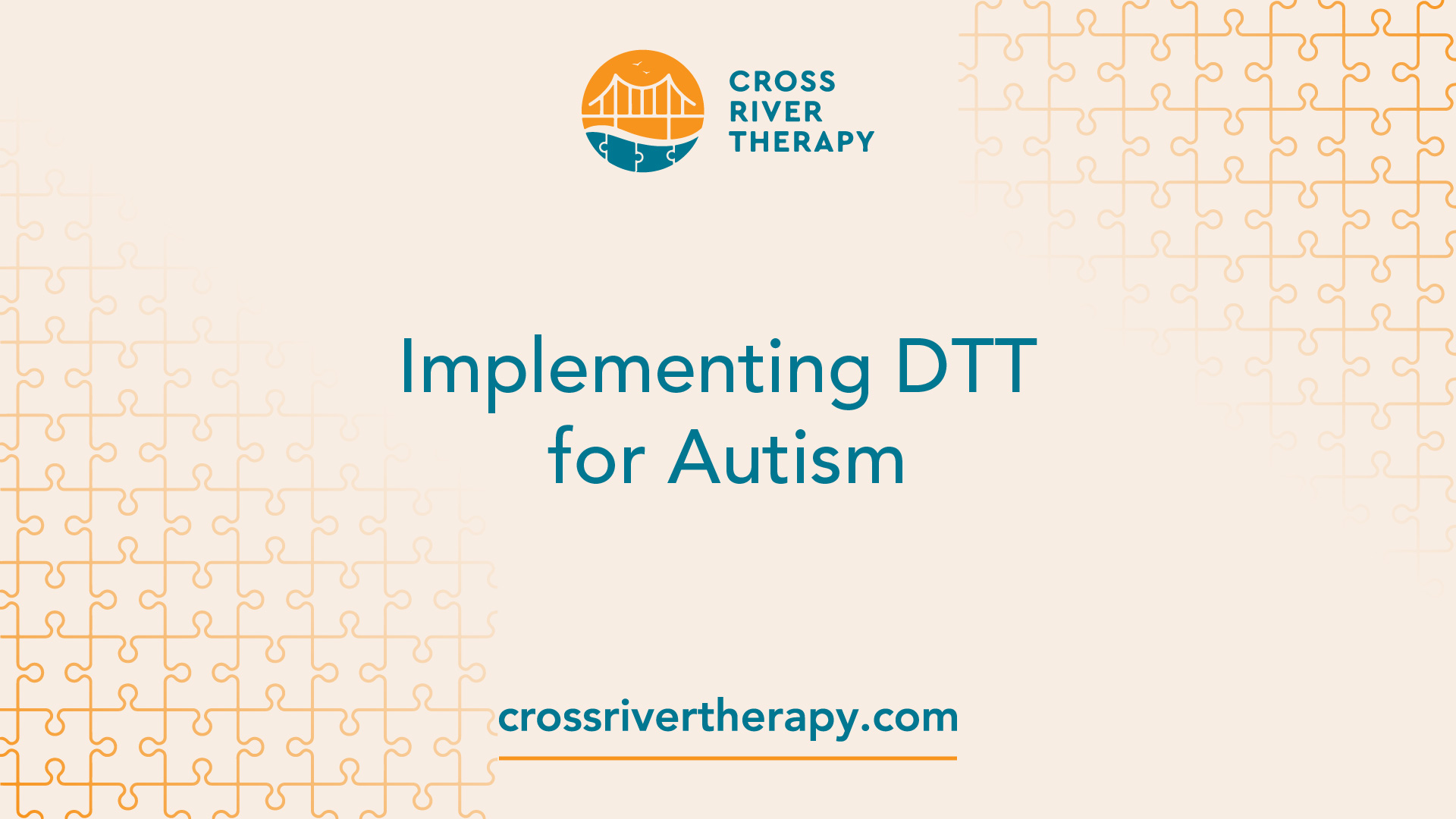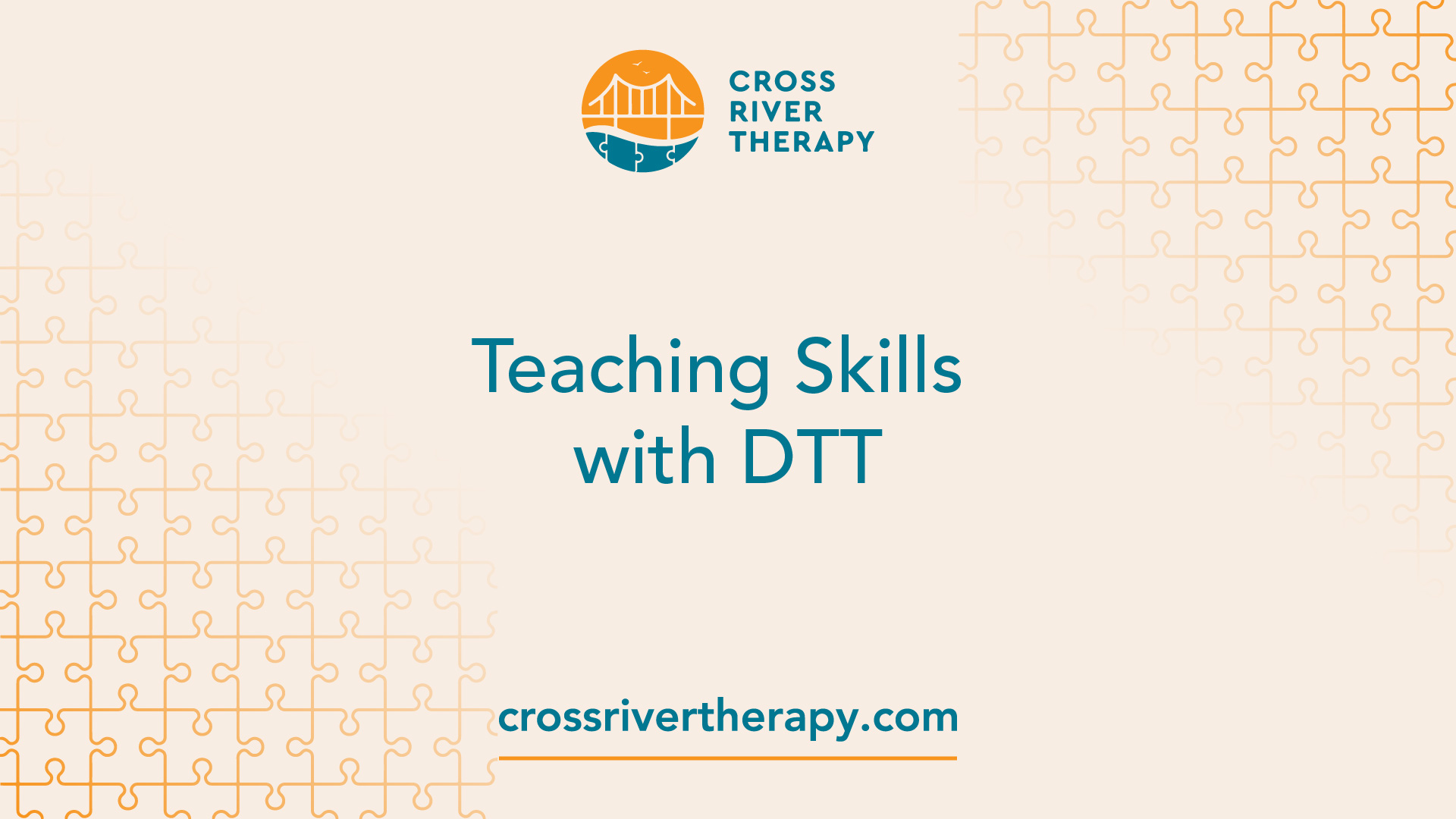What Is Discrete Trial Training in ABA Therapy?
Unlock the power of ABA therapy for discrete trial training. Discover effective strategies to support your child's progress.

Understanding Discrete Trial Training
Discrete Trial Training (DTT) is a structured teaching method used in Applied Behavior Analysis (ABA) therapy to break down skills into small, "discrete" components. It involves presenting a stimulus, requiring a specific response, and providing feedback on the correctness of the response.
What is DTT?
DTT is a teaching method used in ABA therapy to teach new skills and behaviors to individuals with autism spectrum disorder (ASD) by breaking down complex skills into smaller, more manageable steps. Each step is taught one at a time, allowing for mastery before moving on to the next step.
The structured nature of DTT involves the therapist or instructor presenting a specific stimulus or instruction to the learner, such as a verbal cue or a visual prompt. The learner is then expected to respond in a specific way. This response is reinforced or corrected, providing immediate feedback to the learner. Through repetition and practice, the learner gradually acquires and generalizes the targeted skills.
Effectiveness of DTT
DTT has been proven to be an effective method for teaching new skills and reducing problem behaviors in individuals with autism and other developmental disorders. The structured nature of DTT sessions allows for efficient learning and skill acquisition.
Research has shown that DTT can lead to significant improvements in communication, social, academic, and daily living skills for individuals with autism. The discrete and systematic approach of DTT helps learners focus on specific skills, leading to better understanding and retention. The individualized nature of DTT allows therapists to tailor the program to the specific needs and goals of each individual.
By breaking down skills into smaller components and providing immediate feedback, DTT maximizes the learning potential of individuals with autism. It allows for targeted instruction and reinforcement, helping individuals acquire skills that may be challenging for them [3].
In the following sections, we will explore how DTT is implemented in ABA therapy and how it can be used to teach a wide range of skills across various domains.
Implementing DTT for Autism

When it comes to teaching new skills and behaviors to individuals with autism spectrum disorder (ASD), Discrete Trial Training (DTT) is a widely used technique in Applied Behavior Analysis (ABA). This structured teaching method involves breaking down complex skills into smaller, more manageable steps and teaching each step one at a time. In the context of implementing DTT for autism, two key aspects to consider are tailoring DTT programs and data collection.
Tailoring DTT Programs
DTT can be highly individualized and tailored to the specific needs and abilities of each learner. This allows therapists to customize and adapt the program based on the goals and challenges of the individual with autism [1]. DTT can be used to teach a wide range of skills across various domains, including communication, social, academic, and daily living skills. By breaking down complex skills into smaller, more achievable steps, individuals with autism can experience success and build upon their skills incrementally.
The customization of DTT programs involves assessing the individual's strengths and areas for improvement. Therapists work closely with the individual and their family to identify target skills and set specific goals. The program is then designed to address these specific areas and help the individual progress in their development.
Data Collection in DTT
Data collection is a vital component of DTT as it allows therapists to track progress, make data-driven decisions, and evaluate the effectiveness of the program. By collecting data during DTT sessions, therapists can objectively measure the individual's responses and track their progress over time.
Data collection in DTT involves recording specific information about each trial, including the trainer's presentation, the child's response, and the consequence. This data helps identify patterns, assess skill acquisition, and make informed decisions regarding instructional strategies and modifications.
To facilitate data collection, therapists often use data collection sheets or electronic devices specifically designed for this purpose. These tools allow for efficient and accurate recording of data during DTT sessions. The collected data can also be analyzed to determine the effectiveness of the program and make adjustments as needed.
By tailoring DTT programs and implementing effective data collection practices, therapists can maximize the benefits of DTT for individuals with autism. This individualized approach, combined with consistent and accurate data collection, helps ensure that DTT programs are tailored to the specific needs of each learner and promote meaningful progress in their development.
Teaching Skills with DTT

Discrete Trial Training (DTT) is a highly effective technique used in ABA therapy to teach a wide range of skills to individuals with autism spectrum disorder (ASD). By breaking down skills into smaller, "discrete" components, DTT focuses on teaching these skills one by one and using tangible reinforcements for desired behavior. Let's explore two important aspects of teaching skills with DTT: skill domains and generalization.
Skill Domains in DTT
DTT can be used to teach skills across various domains, including communication, social, academic, and daily living skills. The individualized nature of DTT allows therapists to tailor the program to the specific needs and goals of each individual [1]. This means that a DTT program can be designed to target specific areas of development, such as:
- Communication Skills: DTT can be used to teach expressive language skills, receptive language skills, and functional communication skills. It focuses on building language abilities through targeted interventions and reinforcement.
- Social Skills: DTT can help individuals with ASD develop social interaction skills, such as turn-taking, sharing, and following social cues. By breaking down these skills into smaller components, therapists can provide structured opportunities for social learning.
- Academic Skills: DTT is effective for teaching academic skills such as reading, writing, math, and problem-solving. By breaking down complex academic tasks into smaller steps, individuals can learn and master each component before moving on to the next.
- Daily Living Skills: DTT can also be used to teach essential daily living skills, such as personal hygiene, self-care, and household chores. This approach helps individuals with ASD develop independence and functional skills for everyday life.
Generalization in DTT
Generalization is an important goal of DTT. It refers to the ability to apply learned skills in different settings, with different people, and in different situations. While initially teaching skills in a structured environment, therapists using DTT gradually introduce opportunities for generalization by incorporating naturalistic teaching strategies.
To promote generalization, therapists using DTT may:
- Vary the Setting: Practicing skills in different settings helps individuals generalize their skills beyond the therapy room. For example, if teaching social skills, therapists may incorporate community outings to provide opportunities for individuals to practice their skills in real-life situations.
- Include Different People: Expanding the individuals' interactions with different people helps generalize social skills. This may involve including peers, family members, or other individuals in the therapy sessions to create a more natural social environment.
- Use Different Materials: Introducing a variety of materials and stimuli helps individuals generalize their skills to different contexts. For instance, if teaching academic skills, therapists may use different books, worksheets, or manipulatives to ensure individuals can apply their knowledge across different materials.
- Promote Generalization Across Time: Teaching skills in a way that encourages individuals to apply them consistently over time is essential. Therapists may incorporate maintenance sessions and periodic reviews to strengthen and reinforce previously learned skills.
By incorporating generalization strategies into DTT, therapists aim to ensure that individuals with ASD can use their newly acquired skills in real-world settings, enhancing their overall independence and quality of life.
In the next section, we will discuss the importance of structuring DTT sessions and the components involved in the process.
Structuring DTT Sessions
To effectively implement Discrete Trial Training (DTT) in Applied Behavior Analysis (ABA) therapy, it is important to understand the components of DTT and the role of data analysis in monitoring progress and making informed decisions.
Components of DTT
DTT sessions are characterized by repetition, structure, and consistency, which contribute to its effectiveness in teaching new skills and reducing problem behaviors [1]. The components of DTT typically include:
- Antecedent: A specific stimulus or cue is presented to initiate a trial.
- Discriminative Stimulus (SD): The SD is the specific instruction or question presented to the learner to evoke a targeted response.
- Response: The learner's response to the SD is observed and recorded.
- Consequence: Based on the learner's response, appropriate consequences such as reinforcement or corrective feedback are provided.
- Intertrial Interval (ITI): A brief pause separates each trial to allow for a clear distinction between trials.
By breaking down complex skills into smaller, more manageable steps, DTT facilitates effective teaching and learning. It enables the learner to focus on one specific skill or behavior at a time, promoting skill acquisition and reducing confusion.
Data Analysis in DTT
Data collection and analysis play a crucial role in DTT, allowing for ongoing evaluation of an individual's progress and the effectiveness of teaching strategies. By systematically collecting data, therapists and behavior analysts can gain valuable insights into the learner's skill acquisition, identify areas of strength and areas that require additional support, and make informed decisions about modifying or advancing the program.
Data collection methods in DTT typically involve recording various aspects of the learner's performance during each trial, including correct responses, errors, prompt levels, and response latency. This data is then analyzed to track progress, identify patterns, and guide instructional decisions.
The frequency and format of data collection may vary depending on the specific goals and needs of the learner. It is essential to establish clear and consistent data collection procedures to ensure accuracy and reliability. Graphing the data over time can provide a visual representation of the learner's progress and help identify trends or patterns.
By regularly analyzing the collected data, therapists can determine whether the current teaching strategies are effective or if adjustments need to be made. This data-driven approach allows for individualized instruction and ensures that the learner is making meaningful progress.
In conclusion, structuring DTT sessions involves implementing the key components of DTT, including antecedents, discriminative stimuli, responses, consequences, and intertrial intervals. Additionally, data analysis is a vital part of DTT, enabling therapists to track progress, make informed decisions, and tailor the program to the individual learner's needs. By incorporating these elements, DTT can effectively promote skill acquisition and support the development of individuals with autism spectrum disorder (ASD).
Challenges and Considerations
Implementing Discrete Trial Training (DTT) in ABA therapy can bring about various challenges and considerations. Two important factors to address are time management and prompting.
Time Management in DTT
DTT requires structured and repetitive teaching sessions, making it a time-intensive intervention. The intensity of instruction, involving several hours of direct 1:1 interaction per day over an extended period, facilitates learning for individuals on the autism spectrum. However, balancing the time commitment required for DTT with other daily responsibilities can be a challenge for parents and caregivers.
To effectively manage time during DTT sessions, it is essential to establish a structured schedule. This involves setting aside dedicated time for DTT sessions, ensuring consistency and regularity. Creating a visual schedule or utilizing timers can help individuals stay organized and transition smoothly between activities. Additionally, seeking support from professionals and other family members can assist in managing time effectively and reducing the burden.
Prompting in DTT
Prompting plays a crucial role in guiding individuals with developmental disabilities through DTT sessions. It helps to facilitate correct responses and promote skill acquisition. However, there is a potential risk of overreliance on prompts, which can hinder the individual's ability to generalize skills across different contexts and settings [6].
To address this challenge, it is important to strike a balance between providing effective prompts and promoting independence. Gradually reducing prompts over time is vital for fostering skill generalization and independence. Implementing systematic prompting fade procedures can help individuals gradually become more independent in their responses. This involves systematically reducing the level of prompting provided, allowing learners to demonstrate skills without excessive reliance on prompts.
By addressing time management and prompting challenges in DTT, caregivers and professionals can optimize the effectiveness of the intervention. With proper time allocation and the implementation of prompt fading procedures, individuals undergoing DTT can develop essential skills and increase their independence in various settings.
Maximizing Effectiveness of DTT
To maximize the effectiveness of ABA therapy using Discrete Trial Training (DTT), it is important to consider individualized approaches and implement prompting fade procedures.
Individualized Approach in DTT
DTT can be highly individualized and tailored to the specific needs and abilities of each learner, allowing for customization and flexibility in teaching different skills and targeting specific areas of development such as communication, social interaction, self-help, and academic skills. By understanding and considering the unique characteristics, preferences, and strengths of the individual with autism, therapists and educators can modify the DTT programs to optimize learning outcomes.
Individualization can involve various strategies, such as using preferred reinforcers or incorporating the learner's specific interests into the teaching materials. It is crucial to assess the individual's current skills, identify target areas for improvement, and set appropriate goals. Regular assessments and progress monitoring allow for ongoing adjustments and refinements to ensure that the DTT program remains effective and relevant for the individual's developmental journey.
Prompting Fade Procedures
Prompting is an essential part of DTT, as it helps individuals acquire and generalize new skills by providing guidance and support. However, the ultimate goal is to fade out prompts gradually, allowing the learner to demonstrate the skill independently. Prompting fade procedures involve systematically reducing the level of assistance provided during trials, promoting independence and skill mastery.
There are several prompting strategies that can be employed in DTT, including physical prompts, gestural prompts, verbal prompts, and visual prompts. The fading process typically starts with a more intrusive prompt and gradually progresses to less intrusive prompts until the individual can perform the skill without any assistance. This gradual fading allows for skill acquisition while minimizing prompt dependency.
It is important for therapists and educators to carefully monitor progress and adjust the fading process based on the individual's response. By gradually reducing prompts and providing reinforcement for independent responses, individuals with autism can develop greater independence and self-reliance in acquiring and demonstrating new skills.
By adopting an individualized approach and implementing prompting fade procedures, ABA therapy using DTT can be optimized for individuals with autism. This approach acknowledges the unique needs and strengths of each learner, promoting personalized skill development and progression. Continuous assessment, data collection, and collaboration between therapists, educators, and caregivers are crucial for maximizing the effectiveness of DTT in helping individuals with autism reach their full potential.
References
[3]: https://www.autismspeaks.org/expert-opinion/what-discrete-trial-training
[4]: https://iidc.indiana.edu/irca/articles/discrete-trial-teaching-what-is-it.html
[5]: https://www.adinaaba.com/post/discrete-trial-training-in-aba-therapy
[6]: https://www.educationalwave.com/pros-and-cons-of-discrete-trial-training/



